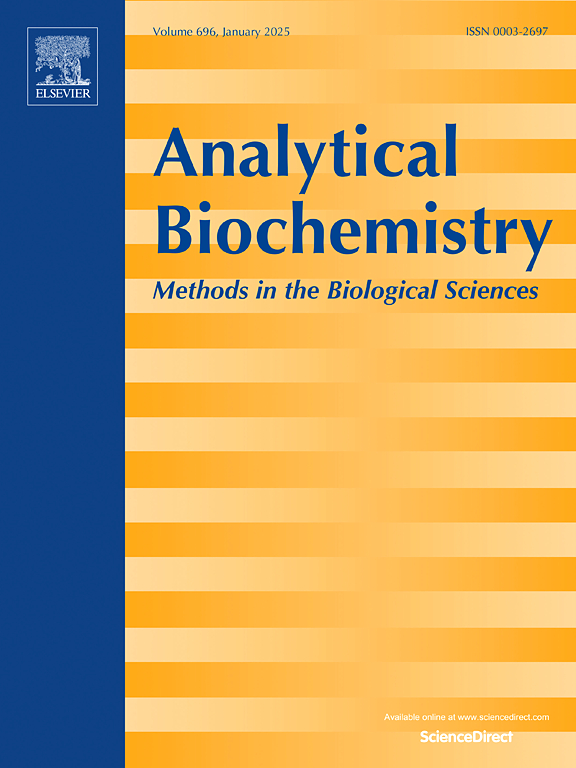Simultaneous voltammetric determination of 3-methyladenine and adenine at disposable screen-printed carbon electrode
IF 2.5
4区 生物学
Q2 BIOCHEMICAL RESEARCH METHODS
引用次数: 0
Abstract
The anodic behavior of 3-methyladenine (3-mAde) and adenine (Ade) were investigated in aqueous media on commercial screen-printed carbon electrodes (SPCEs), using cyclic voltammetry (CV) and differential pulse voltammetry (DPV). The electrochemical performance of the SPCEs was first evaluated by CV and using the [Fe(CN)6]3- redox probe. The electroactive areas of some SPCEs were also determined and discussed. Overall, the results were very satisfactory and indicated good repeatability and reproducibility of the SPCEs. Regarding 3-mAde its oxidation occurred in a single irreversible step pH dependent controlled by a diffusion layer and at more positive potential, ∼ +200.00 mV, in relation to Ade, demonstrating the possibility of simultaneous detection of these two biomarkers. By DPV experimental conditions were explored to increase the sensitivity and selectivity of the 3-mAde electrooxidation signal, such as influence of the composition and pH of the medium, effect of 3-mAde concentration and presence of possible interferents. A simple, sensitive, selective and fast electroanalytical method, using DPV and commercial SPCE, was developed for determination of 3-mAde in hydrolyzed DNA samples; with a linear range from 2.00 to 10.00 μmol L−1, limit of detection (LOD) of 0.35 μmol L−1 and recoveries ranged from 96.0 % to 98.3 % in acetate buffer (pH = 4.10). For the simultaneous quantification of Ade and 3-mAde the analytical data were: concentration range of 0.50–10.00 μmol L−1, LOD of 0.34 μmol L−1 and the mean recovery was 95.2 % for Ade and from 2.00 to 10.00 μmol L−1, LOD of 0.64 μmol L−1 and the mean recovery was 101.3 % for 3-mAde.

一次性丝网印刷碳电极上3-甲基腺嘌呤和3-甲基腺嘌呤的同时伏安测定
使用循环伏安法(CV)和差分脉冲伏安法(DPV)研究了 3-甲基腺嘌呤(3-mAde)和腺嘌呤(Ade)在水介质中对商用丝网印刷碳电极(SPCE)的阳极行为。首先使用 CV 和[Fe(CN)6]3-氧化还原探针评估了 SPCE 的电化学性能。此外,还测定并讨论了一些 SPCE 的电活性区域。总的来说,结果非常令人满意,表明 SPCE 具有良好的可重复性和再现性。关于 3-mAde,其氧化发生在一个不可逆的步骤中,与 pH 值有关,由扩散层控制,与 Ade 相比,电位更正,为 +200.00 mV,这证明了同时检测这两种生物标记物的可能性。通过 DPV 实验,探索了提高 3-mAde 电氧化信号灵敏度和选择性的条件,如介质成分和 pH 值的影响、3-mAde 浓度的影响以及可能存在的干扰物。该方法的线性范围为 2.00 至 10.00 μmol L-1,检出限(LOD)为 0.35 μmol L-1,在醋酸盐缓冲液(pH = 4.10)中的回收率为 96.0 % 至 98.3 %。同时定量分析 Ade 和 3-mAde 的分析数据为:Ade 的浓度范围为 0.50-10.00 μmol L-1,检测限为 0.34 μmol L-1,平均回收率为 95.2%;3-mAde 的浓度范围为 2.00-10.00 μmol L-1,检测限为 0.64 μmol L-1,平均回收率为 101.3%。
本文章由计算机程序翻译,如有差异,请以英文原文为准。
求助全文
约1分钟内获得全文
求助全文
来源期刊

Analytical biochemistry
生物-分析化学
CiteScore
5.70
自引率
0.00%
发文量
283
审稿时长
44 days
期刊介绍:
The journal''s title Analytical Biochemistry: Methods in the Biological Sciences declares its broad scope: methods for the basic biological sciences that include biochemistry, molecular genetics, cell biology, proteomics, immunology, bioinformatics and wherever the frontiers of research take the field.
The emphasis is on methods from the strictly analytical to the more preparative that would include novel approaches to protein purification as well as improvements in cell and organ culture. The actual techniques are equally inclusive ranging from aptamers to zymology.
The journal has been particularly active in:
-Analytical techniques for biological molecules-
Aptamer selection and utilization-
Biosensors-
Chromatography-
Cloning, sequencing and mutagenesis-
Electrochemical methods-
Electrophoresis-
Enzyme characterization methods-
Immunological approaches-
Mass spectrometry of proteins and nucleic acids-
Metabolomics-
Nano level techniques-
Optical spectroscopy in all its forms.
The journal is reluctant to include most drug and strictly clinical studies as there are more suitable publication platforms for these types of papers.
 求助内容:
求助内容: 应助结果提醒方式:
应助结果提醒方式:


